Related:
Oxford’s Living Libraries: Botanic Garden and Harcourt Arboretum

“No village or individual shall be compelled to make bridges at river banks,
except those who from of old are legally bound to do so.”
— Magna Cara Clause 23 (Limiting forced labor for infrastructure)

“Clare Hall and King’s College Chapel, Cambridge, from the Banks of the River Cam” / Joseph Mallord William Turner (1793)
Smart Infrastructure: Getting More From Strategic Assets
Dr Jennifer Schooling, Director of CSIC
Dr Ajith Parlikad, CSIC Co-Investigator and Senior Lecturer
Mark Enzer, Global Water Sector Leader
Mott MacDonald; Keith Bowers, Principal Tunnel Engineer, London Underground
Ross Dentten, Asset Information and Configuration Manager, Crossrail
Matt Edwards, Asset Maintenance and Information Manager, Anglian Water Services
Jerry England, Group Digital Railway Director, Network Rail
Volker Buscher, Director, Arup Digital
Smart Infrastructure is a global opportunity worth £2trn-4.8trn. The world is experiencing a fourth industrial revolution due to the rapid development of technologies and digital abundance.
Smart Infrastructure involves applying this to economic infrastructure for the benefit of all stakeholders. It will allow owners and operators to get more out of what they already have, increasing capacity, efficiency and resilience and improving services.
It brings better performance at lower cost. Gaining more from existing assets is the key to enhancing service provision despite constrained finance and growing resource scarcity. It will often be more cost-effective to add to the overall value of mature infrastructure via digital enhancements than by physical enhancements – physical enhancements add `more of the same’, whereas digital enhancements can transform the existing as well.
Smart Infrastructure will shape a better future. Greater understanding of the performance of our infrastructure will allow new infrastructure to be designed and delivered more efficiently and to provide better whole-life value.
Data is the key – the ownership of it and the ability to understand and act on it. Industry, organisations and professionals need to be ready to adjust in order to take advantage of the emerging opportunities. Early adopters stand to gain the most benefit. Everyone in the infrastructure sector has a choice as to how fast they respond to the changes that Smart Infrastructure will bring. But everyone will be affected.
Change is inevitable. Progress is optional. Now is the time for the infrastructure industry to choose to be Smart.
LEARN MORE:
Cambridge Centre for Smart Infrastructure and Construction
Perspective: Since this paper is general in its recommendations, we provide examples of specific campus infrastructure data points that are difficult, if not impossible, to identify and “make smart” — either willfully, for lack of funding, for lack of consensus, for lack of understanding or leadership:
Come see ‘Pygmalion’ this weekend at Arno Gustin Hall on campus! University of Mary students bring this classic to life in a riveting weekend of performances. 🎬
Showtimes:
Friday – 7:00pm
Saturday – 2:00pm & 7:00pm
Sunday – 2:00pm#Lifeatmary pic.twitter.com/5w5MnEWk4K— University of Mary (@umary) March 21, 2025
![]()
Welcome to Leeds Student Radio | By Students, For Students
@ThisIsLSR @IEEECampus https://t.co/ZW3efm7L8nhttps://t.co/aUy9sWf2rw pic.twitter.com/TZsf362CJH— Standards Michigan (@StandardsMich) May 6, 2023
🛍️ BUY YOURS NOW 🛍️
Follow the link below! ⬇️👇🛍️https://t.co/Kq056Bzd8K
There are three ways that you can join this amazing network of 50+ stations…
• Station Membership 🎙️📻
• Individual Membership 🤝
• Alumni Membership 👋🎓#SRA #SRAAwards #SRACon pic.twitter.com/du2C2zkRqH— Student Radio Association (@SRA) August 3, 2023
A rare find in best practice literature is a title that slices horizontally through a number of “silos” owned by US-based domain incumbents such as NFPA, ICC, IEEE and others. Several occupancy classifications run interstitially and present challenging risk aggregations–similarly recognized in the EU–when 100,000 people must be put out of harms way in less than 60 seconds. One such title is Code of Practice: BS 7827 Designing, specifying, maintaining and operating emergency sound systems for sports grounds, large public buildings, and venues. From the project prospectus:
Maintenance, Emergency measures, Safety devices, Reports, Crowd safety, Certification (approval), Inspection, Audio systems, Forms (paper), Speech transmission systems, Reliability, Instructions for use, Personnel, Sound intensity, Approval testing, Training, Audio equipment, Performance, Stadia, Warning devices, Electric power systems, Alarm systems, Signal distortion, Sports facilities, Safety measures, Public-address systems, Audibility, Acoustic measurement, Reception, Sound reproduction, Buildings, Control panels
The current 2019 Edition was released October 2019 and is assumed to be stable. You can tell by the list of normative references from European Union standards developers that event safety is an established discipline and one that requires continual attention despite the circumstances of the pandemic.

Michigan Stadium is the largest university-owned sports venue in the world. with nominal seating capacity of 110,000 and auxiliary enterprises that add another 20,000.
More information about how our colleagues may contribute to the development of future revisions to this titles should communicate directly with BSI Group Technical Committee EPL/100. We collaborate with European Union electrotechnical professionals through the IEEE Education & Healthcare Facilities Committee which meets online 4 times monthly in European and American time zones.






We maintain this title on the standing agenda of our Sport and Global colloquia. See our CALENDAR for the next online meeting; open to everyone.
Issue:[19-158]
Category: Sport, Global, Information & Communications Technology, Life Safety
Colleagues: Mike Anthony, Jim Harvey, Mike Hiler
“Thine Be the Glory” (originally “À toi la gloire” in French) is a Christian hymn written by Swiss pastor and hymnwriter Edmond Louis Budry in 1884. The hymn was composed to celebrate the Resurrection of Jesus Christ, making it particularly associated with Easter. Budry, a minister in the Reformed Church of Vevey, Switzerland, wrote the text in French, inspired by the triumphant and victorious nature of Christ’s resurrection.
The tune commonly used for the hymn is adapted from a piece in George Frideric Handel’s oratorio Judas Maccabaeus (1747), specifically the chorus “See, the Conqu’ring Hero Comes.” This lively and majestic melody was arranged for the hymn by 1885, when the text and tune were first published together in the Swiss hymnal L’Organiste. The English translation, which begins “Thine be the glory, risen, conqu’ring Son,” was made by Richard Birch Hoyle in 1923, enabling the hymn to gain widespread popularity in English-speaking congregations.
The hymn’s text draws heavily on biblical themes, particularly from the New Testament accounts of the Resurrection (e.g., Matthew 28, 1 Corinthians 15). It emphasizes Christ’s victory over death, the hope of eternal life, and the call for believers to offer praise and glory to God.
Thine be the glory, risen, conquering Son;
endless is the victory, thou o’er death hast won;
angels in bright raiment rolled the stone away,
kept the folded grave clothes where thy body lay.
Refrain:
Thine be the glory, risen conquering Son,
Endless is the vict’ry, thou o’er death hast won.
Lo! Jesus meets us, risen from the tomb;
Lovingly he greets us, scatters fear and gloom;
let the Church with gladness, hymns of triumph sing;
for her Lord now liveth, death hath lost its sting.
No more we doubt thee, glorious Prince of life;
life is naught without thee; aid us in our strife;
make us more than conquerors, through thy deathless love:
bring us safe through Jordan to thy home above.
New update alert! The 2022 update to the Trademark Assignment Dataset is now available online. Find 1.29 million trademark assignments, involving 2.28 million unique trademark properties issued by the USPTO between March 1952 and January 2023: https://t.co/njrDAbSpwB pic.twitter.com/GkAXrHoQ9T
— USPTO (@uspto) July 13, 2023
Standards Michigan Group, LLC
2723 South State Street | Suite 150
Ann Arbor, MI 48104 USA
888-746-3670
